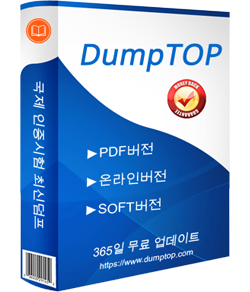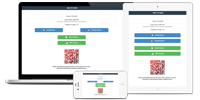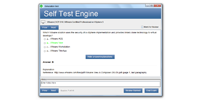IT 업계의 선두자로서 저희의 목표는 IT인증시험에 참가하는 모든 분들께 도움을 제공해드리는 것입니다. 이 목표를 달성하기 위해 저희의 전문가들은 시간이 지날수록 쌓이는 경험과 노하우로 IT자격증시험 응시자분들을 지원하고 있습니다.덤프제작팀의 엘리트들은 최선을 다하여 근년래 출제된 Windows Embedded Standard 7 for Developers 시험문제의 출제경향을 분석하고 정리하여 가장 적중율 높은 70-582시험대비 자료를 제작하였습니다.이와 같은 피타는 노력으로 만들어진 70-582 덤프는 이미 많은 분들을 도와 70-582시험을 패스하여 자격증을 손에 넣게 해드립니다.
시험대비자료는 덤프가 최고
처음으로 자격증에 도전하시는 분들이 많을것이라 믿습니다.우선 시험센터나 인증사 사이트에서 고객님께서 취득하려는 자격증이 어느 시험을 보셔야 취득이 가능한지 확인하셔야 합니다.그리고 시험시간,출제범위,시험문항수와 같은 Windows Embedded Standard 7 for Developers시험정보에 대해 잘 체크하신후 그 시험코드와 동일한 코드로 되어있는 덤프를 구매하셔서 시험공부를 하시면 됩니다.70-582덤프구매전 사이트에서 일부분 문제를 다운받아 덤프유효성을 확인하셔도 좋습니다.저희 사이트의 영원히 변치않는 취지는 될수있는 한 해드릴수 있는데까지 70-582시험 응시자 분들께 편리를 가져다 드리는것입니다. 응시자 여러분들이 시험을 우수한 성적으로 합격할수 있도록 적중율 높은 덤프를 제공해드릴것을 약속드립니다.
덤프유효기간을 최대한 연장
70-582덤프를 구매하시면 1년무료 업데이트 서비스를 제공해드립니다.덤프제작팀은 거의 매일 모든 덤프가 업데이트 가능한지 체크하고 있는데 업데이트되면 고객님께서 덤프구매시 사용한 메일주소에 따끈따끈한 가장 최신 업데이트된 70-582덤프자료를 발송해드립니다.고객님께서 구매하신 덤프의 유효기간을 최대한 연장해드리기 위해 최선을 다하고 있지만 혹시라도 Windows Embedded Standard 7 for Developers시험문제가 변경되어 시험에서 불합격 받으시고 덤프비용을 환불받는다면 업데이트 서비스는 자동으로 종료됩니다.
자격증의 필요성
IT업계에 종사하시는 분께 있어서 국제인증 자격증이 없다는 것은 좀 심각한 일이 아닌가 싶습니다. 그만큼 자격증이 취직이거나 연봉협상, 승진, 이직 등에 큰 영향을 끼치고 있습니다. 70-582시험을 패스하여 자격증을 취득하시면 고객님께 많은 이로운 점을 가져다 드릴수 있습니다. 이렇게 중요한 시험인만큼 고객님께서도 시험에 관해 검색하다 저희 사이트까지 찾아오게 되었을것입니다. 70-582덤프를 공부하여 시험을 보는것은 고객님의 가장 현명한 선택이 될것입니다.덤프에 있는 문제를 마스터하시면 Windows Embedded Standard 7 for Developers시험에서 합격할수 있습니다.구매전이거나 구매후 문제가 있으시면 온라인서비스나 메일상담으로 의문점을 보내주세요. 친절한 한국어 서비스로 고객님의 문의점을 풀어드립니다.
최신 MCTS 70-582 무료샘플문제:
1. You are deploying a Windows Embedded Standard 7 custom image to 5,000 target devices over a network. You need to automate the process of installing custom files and folders during image installation. What should you do?
A) Install the standard image by using Image Builder Wizard (IBW). Copy the custom files and folders from a network-accessible share to their location on the target. Run the Sysprep /oobe command.
B) Use the lmageX.exe tool to capture the custom files and folders to a Windows Image (WIM) file. Save the file to a network-accessible share. Modify the images answer file to provide the source and destination locations for the WIM file. Install the standard image by using Image Builder Wizard (IBW) along with the answer file.
C) Install the standard image to a reference target. Copy the custom files and folders from a network-accessible share to their destination location on the target. Start the target in WindowsPE and use the lmageX.exe tool to capture the image. Deploy the standard image to multiple computers by using WindowsPE and lmageX.exe.
D) Install the standard image by using Image Builder Wizard (IBW). Run the Sysprep /audit /generalize /shutdown command to start the computer in Audit mode. Copy the custom files and folders from a network-accessible share to their location on the target. Run the Sysprep /generalize/oobe /shutdown command.
2. You have a resealed Windows Embedded Standard 7 image on a target device. The image will be deployed to multiple devices. You are provided two text files named Exclusionl_ist.txt and Exclusion.txt. The ExclusionI_ist.txt file contains the following text: [ExclusionList] *.XR5 The Exclusion.txt file contains the following text: [Exclusion] *.XR5 You need to ensure that the captured image meets the following requirements: It remains resealed.lt excludes files that contain the XR5 extension.lt can be used for successful deployment on multiple devices. What should you do?
A) Start the device by using WindowsPE. Use the ImageX tool along with the /CAPTURE and /CONFIG Exclusion.txt switches to capture a Windows Image (WIM) file.
B) Start the device by using
the
installed
image. Use the ImageX
tool along with the /CAPTURE and/CONFIG Exclusionl_ist.txt switches to capture a Windows Image (WIM) file.
C) Start
the
device by using the
installed
image.
Use
the ImageX
tool along
with the /CAPTURE and/CONFIG Exclusion.txt switches to capture a Windows Image (WIM) file.
D) Start the device by using WindowsPE. Use the ImageX tool along with the /CAPTURE and /CONFIG Exclusionl_ist.txt switches to capture a WindowsImage (WIM) file.
3. You are updating a Windows Embedded Standard 7 Windows Image (WIM) file. You download all available updates from the Microsoft D.
Install the language pack for the selected language by using the Ipksetup /i <locale> /p <path to LPxab> command. Update the new language by using the intlcfg Cgenlangini command. Web site. You need to apply the updates to the image. What should you do?
A) Run the DISM tool along with the /Add-Package and /IgnoreCheck options.
B) Run the Package Scanner tool along with the /Find-Updates option to generate an answer file. Run the Sysprep tool along with the/Unattend option to update the image.
C) Run the Package Scanner tool along with the /Find-Updates option to generate an answer file. Run the DISM tool along with the/ApplyJJnattend option to update the image.
D) Run the Package Scanner tool along with the /Get-Packages option to generate an answer file. Run the DISM tool along with the/ApplyJJnattend option to update the image.
4. You are creating a Windows Embedded Standard 7 image for a target device. You have a third-party device driver that is critical during system startup. You have an INF file and binary files for the device driver. You need to add the device driver to the image. What should you do in Image Configuration Editor (ICE)?
A) Configure the DriverPaths setting to install the device driver during the auditSystem pass.
B) From the distribution share, add the device driver from the Out-of-Box Drivers folder. Configure the settings to install the driver during the WindowsPE pass.
C) Insert a synchronous command during the Specialize pass.
D) Insert a synchronous command during the auditUser pass.
5. You are developing a Windows Standard Embedded 7 image for 5,000 target devices. You need to ensure that each device receives a unique security ID (SID). What should you do in the reference image?
A) Run the Sysprep /audit /unattend:AutoUnattend.xml command. In the answer file for the image, set Security-SPP\SkipRearm to 0.
B) Run the Sysprep /generalize /oobe /shutdown command.
C) Run the Sysprep /oobe /reboot command.
D) Run the Sysprep /audit /shutdown command. After the installation of the image to a device, start the device and run the Sysprep /oobe/shutdown command.
질문과 대답:
| 질문 # 1 정답: B | 질문 # 2 정답: D | 질문 # 3 정답: C | 질문 # 4 정답: B | 질문 # 5 정답: B |


 337 고객 리뷰
337 고객 리뷰





